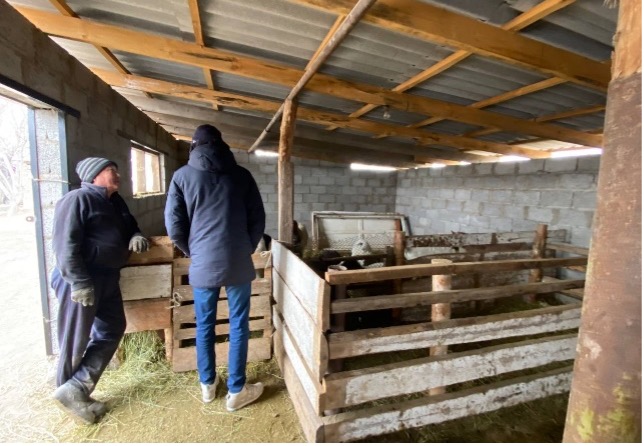Kyrgyzstan: Livestock lives on
.jpg)
Kyrgyzstan is a Central-Asian country whose major industry is animal husbandry. About 93% of the territory is mountainous, and 54% of it is proper for developing animal husbandry, which amounts to 11 million hectares. Moreover, there are lots of glaciers and rivers, providing clean and abundant water, which creates the perfect condition for animal husbandry. There are 7 states and 2 main cities (the capital, Bishkek, and Osh in the south). The number of people working in the husbandry industry is comparatively lower because of the economic development. However, the industry is still important in the 7 states. There are around a third of the national population who are working in the animal husbandry industry.
Take the Chui state, for example. It accounted for 25% of the nations’ meat and milk production, 18% of the cows, and 61% of the eggs production, which shows how important the husbandry industry is in the local economy.

Among the locals, people view the number of livestock as a measurement of wealth. Livestock is a very reliable asset, not only can people sell them for cash when needed, but also let them reproduce to make profits from it. The livestock also produces milk and eggs, which provide nutrients for the families, who can also sell the extra for cash.
“When the parents see livestock, their eyes sparkled.” Described by the social worker who’s responsible for the livestock project. The TFCF Kyrgyzstan Branch Office started the project in 2019. The main goal behind the project is sustainability and the husbandry tradition in the region.
During the first year for the newly joined family, we would provide pregnant cows, chickens, and does to families in need. We would also hire professionals to assist the families in building husbandry-related skills, to improve the survival rate and fertility rate of the animals.
When the animals successfully reproduce, the families would give some of the calves and lambs to us, and we would distribute them to other families in need. So on and so forth. We would also provide support and training to let the projects impact more families.
Compare with other projects, the livestock project has a higher operating cost, which means that we evaluate the families we want to help much more cautiously. After our local social workers pay the first visit to the families, the supervisors would then accompany the social workers to make a second visit, and learn about the families’ living situation and living conditions, here are some of the criteria:
(1) If the family members have a sense of responsibility.
(2) If there is enough space to raise livestock.
(3) If they have any experience raising livestock.
(4) If there are enough people raising the livestock.
By the end of 2021, 9 families received a set of livestock, including a pregnant cow and around 5-6 does, and the animals being born were given to 9 other families. So there are 18 families in total who benefited from the projects. And we are planning to increase that number of families benefited to 24.
Besides providing livestock to the families, we also provide a series of capacity building training, such as:
(1) Pasture and feed support: Considering the families’ economic condition isn’t always desirable. To decrease the failure rate, we provide 400 kilograms of pasture and 1 ton of feed to help the animal get through the tough winter.
(2) Renovating the barns: If the living environment is good for the animals, it would greatly affect the health of the animals and the storage of feed. We provide renovating materials for the barns and help the families improve the environment.

(3) Veterinary Support: We hire veterinarians to administer vaccines, and check the pregnancy and health of the animals. The vets could also improve the knowledge of taking care of the animals for the families, which let the families take a hold of the health condition of the livestock in time.
Ever since the project started in January 2019, there are some milestones for the projects, such as:
- The increase in production and assets
(1) The increase in the number of livestock: In 2019, there are 9 cows and 45 does, but in 2022, there are 23 cows and 133 does in this project, the numbers are almost tripled since then.
(2) The increase in milk production: Since the beginning of 2021, the daily average of milk production is 46 liters, which increased to 120 liters at the end of the year. It has to do with the increase of cows and the improvement of the living environment.
(3) 1 in 3 of the families we support with this project since 2019 has been able to gather enough wealth through the project to be on their own and doesn’t need our assistance anymore.
- Improvement of feeding experience and skills raising
(1) Families who participated in the projects could take care of the livestock, and successfully reproduce more animals to increase the overall number.
(2) In the second year of the project, families need to start paying for part of the vet and feed costs. We also provide finance courses to cultivate the parents’ financial knowledge as well as routes for them to sell milk to increase their income. The goal is to let the families afford the cost gradually and finally become independent financially.
This is the fourth year of this project. Besides continuing to improve families’ husbandry skills and financial knowledge, we also try to incorporate the different industries involved in this project to multiply the economic growth in the region.
The TFCF Kyrgyzstan Branch Office emphasizes the supportive relationship among the families participating in this project. We maintain the grassroots spirit and actively participate in the long-running local animal husbandry industry. We hope to cement children’s welfare and create a better living environment for the children.

If you want to support our work in the Kyrgyzstan, you can join us here.
